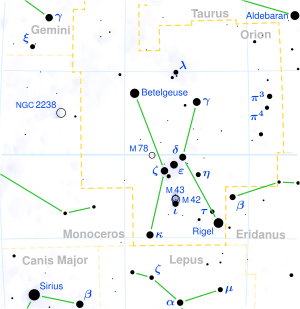Omega Orionis

| |
| Observation data Epoch J2000.0 Equinox J2000.0 (ICRS) | |
|---|---|
| Constellation | Orion |
| Right ascension | 05h 39m 11.14632s[1] |
| Declination | +04° 07′ 17.2795″[1] |
| Apparent magnitude (V) | 4.57[2] |
| Characteristics | |
| Spectral type | B3 Ve[3] |
| U−B color index | −0.76[2] |
| B−V color index | −0.11[2] |
| Astrometry | |
| Radial velocity (Rv) | 20.4[4] km/s |
| Proper motion (μ) | RA: +0.84[1] mas/yr Dec.: +0.00[1] mas/yr |
| Parallax (π) | 2.36 ± 0.29[1] mas |
| Distance | approx. 1,400 ly (approx. 420 pc) |
| Details | |
| Mass | 7.0±0.5[3] M☉ |
| Radius | 5.9[5] R☉ |
| Luminosity | 6,031[6] L☉ |
| Surface gravity (log g) | 3.59±0.10[3] cgs |
| Temperature | 19,000±500[3] K |
| Rotation | 1.37 d[5] |
| Rotational velocity (v sin i) | 179±4[5] km/s |
| Age | 43.6[3] Myr |
| Other designations | |
Omega Orionis (ω Ori) is a star in the constellation Orion. Its apparent magnitude is 4.57[2] and is located approximately 1,400 light years from our solar system. It is surrounded by a cloud of dust, forming a modest reflection nebula over a light-year wide.[8]
Omega Orionis is a B-type main sequence star of spectral type B3 Ve[3] with an effective temperature of 19,000 K.[3] Including a large amount of ultraviolet radiation, Omega Orionis shines with a Luminosity 6,031[6] times greater than the Sun's and it has a radius 5.9[5] times larger than solar radius, The projected rotation speed is 179 km/s – involves a period of 1.37[5] days rotation. However, actual rotation speed can reach 450 km / s, it estimated that its axis is inclined 24° relative to the line of sight.[8] The star has a mass 7.0[3] times that of the Sun, just below the limit beyond which stars explode as supernovas. Its age is estimated at 43.6[3] million years.
As a result of its rapid rotation, Omega Orionis is a Be class star. Among the stars of this class, Omega Orionis was the first where the magnetic field was measured and found to be 1000 times that of the Earth. Omega Orionis is, like many Be stars, a variable star whose brightness varies 0.19 magnitudes. Also, small variations have been observed due to non-radial pulsations with periods of 0.97 and 2.19 days.[8]
References
- 1 2 3 4 5 van Leeuwen, F. (2007), "Validation of the new Hipparcos reduction", Astronomy and Astrophysics, 474 (2): 653–664, arXiv:0708.1752
 , Bibcode:2007A&A...474..653V, doi:10.1051/0004-6361:20078357.
, Bibcode:2007A&A...474..653V, doi:10.1051/0004-6361:20078357. - 1 2 3 4 Nicolet, B. (1978), "Photoelectric photometric Catalogue of homogeneous measurements in the UBV System", Astronomy and Astrophysics Supplement Series, 34: 1–49, Bibcode:1978A&AS...34....1N.
- 1 2 3 4 5 6 7 8 9 Levenhagen, R. S.; Leister, N. V. (2006), "Spectroscopic Analysis of Southern B and Be Stars", Monthly Notices of the Royal Astronomical Society, 371: 252–62, arXiv:astro-ph/0606149
 , Bibcode:2006MNRAS.371..252L, doi:10.1111/j.1365-2966.2006.10655.x.
, Bibcode:2006MNRAS.371..252L, doi:10.1111/j.1365-2966.2006.10655.x. - ↑ Wielen, R.; et al. (1999), Sixth Catalogue of Fundamental Stars (FK6). Part I. Basic fundamental stars with direct solutions, 35, Veröffentlichungen des Astronomisches Rechen-Institut Heidelberg, Bibcode:1999VeARI..35....1W.
- 1 2 3 4 5 Neiner, C.; et al. (November 2012), "An investigation of the magnetic properties of the classical Be star ω Ori by the MiMeS Collaboration", Monthly Notices of the Royal Astronomical Society, 426 (4): 2738−2750, Bibcode:2012MNRAS.426.2738N, doi:10.1111/j.1365-2966.2012.21833.x.
- 1 2 McDonald, I.; et al. (2012), "Fundamental Parameters and Infrared Excesses of Hipparcos Stars", Monthly Notices of the Royal Astronomical Society, 427 (1): 343–57, arXiv:1208.2037
 , Bibcode:2012MNRAS.427..343M, doi:10.1111/j.1365-2966.2012.21873.x.
, Bibcode:2012MNRAS.427..343M, doi:10.1111/j.1365-2966.2012.21873.x. - ↑ "ome Ori -- Be Star", SIMBAD Astronomical Database, Centre de Données astronomiques de Strasbourg, retrieved 2016-12-02.
- 1 2 3 Kaler, James B. (February 17, 2012), "Omega Orionis", Stars, University of Illinois, retrieved 2016-12-03.